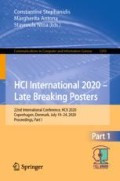Abstract
The current empirical study focuses on speech emotion recognition using speech data extracted from video clips. Although many studies reported speech emotion recognition, the majority of the studies presented were based on using acted and clean speech. A more challenging and realistic task would be using spontaneous noisy speech from video clips. In the current study, the modern and state-of-the-art i-vector features are applied and experimentally evaluated. Comparisons with the widely used low-level descriptors (LLDs) and functionals are also presented. To improve the classification accuracy, a method based on late fusion is investigated. Using the proposed method, higher accuracies were achieved compared to the sole use of individual features. For classification, a fully connected deep neural network (DNN) with several hidden layers was used.
Access this chapter
Tax calculation will be finalised at checkout
Purchases are for personal use only
References
Busso, C., Bulut, M., Narayanan, S.: Toward effective automatic recognition systems of emotion in speech. In: Gratch, J., Marsella, S. (eds.) Social Emotions in Nature and Artifact: Emotions in Human and Human-Computer Interaction, pp. 110–127. Oxford University Press, New York (2013)
Pan, Y., Shen, P., Shen, L.: Speech emotion recognition using support vector machine. Int. J. Smart Home 6(2), 101–108 (2012)
Nicholson, J., Takahashi, K., Nakatsu, R.: Emotion recognition in speech using neural networks. Neural Comput. Appl. 9(4), 290–296 (2000)
Stuhlsatz, A., Meyer, C., Eyben, F., Zielke1, T., Meier, G., Schuller, B.: Deep neural networks for acoustic emotion recognition: raising the benchmarks. In: Proceedings of ICASSP, pp. 5688–5691 (2011)
Han, K., Yu, D., Tashev, I.: Speech emotion recognition using deep neural network and extreme learning machine. In: Proceedings of Interspeech, pp. 2023–2027 (2014)
Lim, W., Jang, D., Lee, T.: Speech emotion recognition using convolutional and recurrent neural networks. In: Proceedings of Signal and Information Processing Association Annual Summit and Conference (APSIPA) (2016)
P-Cabaleiro, E., Costantini, G., Batliner, A., Baird, A., Schuller, B.: Categorical vs dimensional perception of italian emotional speech. In: Proceedings of Interspeech, pp. 3638–3642 (2018)
Hinton, G., et al.: Deep neural networks for acoustic modeling in speech recognition: the shared views of four research groups. IEEE Signal Process. Mag. 29(6), 82–97 (2012)
Dehak, N., Kenny, P.J., Dehak, R., Dumouchel, P., Ouellet, P.: Front-end factor analysis for speaker verification. IEEE Trans. Audio Speech Lang. Process. 19(4), 788–798 (2011)
Schuller, B.W., et al.: The INTERSPEECH 2016 computational paralinguistics challenge: deception, sincerity & native language. In: Proceedings of Interspeech, pp. 2001–2005 (2016)
Sharma, G., Ghosh, S., Dhall, A.: Automatic group level affect and cohesion prediction in videos. In: 2019 8th International Conference on Affective Computing and Intelligent Interaction Workshops and Demos (ACIIW), pp. 161–167 (2019)
Dhal, A., Sharma, G., Goecke, R., Gedeon, T.: EmotiW 2020: driver gaze, group emotion, student engagement and physiological signal based challenges. In: ACM International Conference on Multimodal Interaction 2020 (2020)
Sahidullah, M., Saha, G.: Design, analysis and experimental evaluation of block based transformation in MFCC computation for speaker recognition. Speech Commun. 54(4), 543–565 (2012)
Bielefeld, B.: Language identification using shifted delta cepstrum. In: Fourteenth Annual Speech Research Symposium (1994)
Fukunaga, K.: Introduction to Statistical Pattern Recognition, 2nd edn. Academic Press, New York (1990). Chap. 10
Valstar, M., Schuller, B., et al.: AVEC 2013 - the continuous audio/visual emotion and depression recognition challenge. In: Proceedings of AVEC 2013, pp. 3–10 (2013)
Schuller, B., Steidl, S., Batliner, A.: The INTERSPEECH 2009 emotion challenge. In: Proceedings of Interspeech, pp. 312–315 (2009)
Author information
Authors and Affiliations
Corresponding author
Editor information
Editors and Affiliations
Rights and permissions
Copyright information
© 2020 Springer Nature Switzerland AG
About this paper
Cite this paper
Heracleous, P., Takai, K., Wang, Y., Yasuda, K., Yoneyama, A., Mohammad, Y. (2020). An Empirical Study on Feature Extraction in DNN-Based Speech Emotion Recognition. In: Stephanidis, C., Antona, M., Ntoa, S. (eds) HCI International 2020 – Late Breaking Posters. HCII 2020. Communications in Computer and Information Science, vol 1293. Springer, Cham. https://doi.org/10.1007/978-3-030-60700-5_40
Download citation
DOI: https://doi.org/10.1007/978-3-030-60700-5_40
Published:
Publisher Name: Springer, Cham
Print ISBN: 978-3-030-60699-2
Online ISBN: 978-3-030-60700-5
eBook Packages: Computer ScienceComputer Science (R0)

